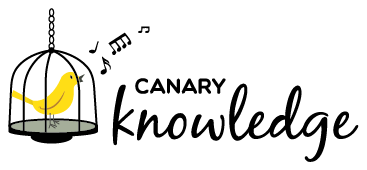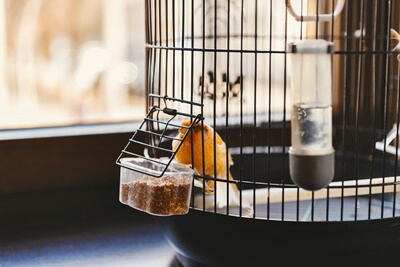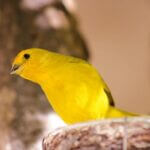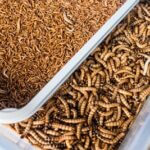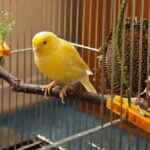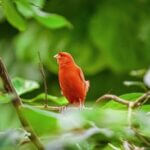It’s rare for wild birds to become fat, but more common in pet birds. After all, pet birds have a steady supply of food, no reason to exercise, and don’t need to provide for themselves.
For canaries especially, genetic factors and routine predispose them to weight gain.
Most canaries get fat due to a poor diet and limited exercise. Canaries should be offered a formulated diet that caters to their nutritional requirements, so they don’t overeat to compensate.
Also, canaries should be given a spacious cage, lots of toys, and different perches to promote activity.
Can Canaries Get Overweight?
Canary obesity involves weighing 15% more than their ideal body weight. Compared to other birds, canaries are more likely to become obese.
The less-social nature of canaries makes owners believe they don’t require space, exercise, and toys to remain active and entertained.
This leaves canaries to live sedentary lifestyles within their cage, burning fewer calories than they ingest. When fed a high-fat, all-seed diet, this leads to weight gain.
Unfortunately, excess weight makes canaries prone to life-threatening illnesses and diseases.
How Much Do Canaries Eat?
Canaries should ideally be fed a formulated, pellet diet, with the amount of feed based on the brand.
The packaging should contain a chart that outlines an average serving size per canary, which you can break up over the day or free-feed.
- Birds on a seed diet should be given 1-2 teaspoons of seeds per day.
- Whether seed-based or pelleted, diets should be supplemented with fruits and vegetables.
- Canaries can safely eat up to 30% of their body weight each day.
According to Biological Sciences, wild birds (including canaries) forage consistently throughout the day.
When kept as pets, offer constant access to food so your canary can control its diet. All birds have a fast metabolism, especially smaller ones, so going without food is dangerous.
You’ll need set feeding times if your canary is prone to gorging or overeating. The average canary may eat 7-8 times per day. Since most people don’t have schedules, automatic feeders are recommended.
Can Canaries Eat Too Much?
Most birds know how to ration their meals appropriately so they don’t gain extra weight. Gorging is rarely instinctual unless there’s a food shortage and the canary feels that it’s unlikely to eat again soon.
Beyond that, wild canaries need to forage for their meals. It’s difficult for canaries to overeat when they fly from place to place to locate food.
In captivity, most birds also eat their fill and stop. Some canaries overeat as a habit, which may be a response to starving, conflict with other birds stealing or guarding food, or stress.
When canaries eat too much, they’ll store excess fat on the body, affecting their ability to hop and fly, which can leave them to sit around and do nothing but eat more.
Average Canary Weight And Size
Canaries don’t have sexual dimorphism. Females and males will have the same average weight and size. This will also be similar to other birds in the finch family:
- Average weight: 12 – 29 grams
- Average size as an adult: 3-5 inches.
How Do I Know If My Bird Is Overweight?
As mentioned, canaries are well-loved for their colorful and fluffy plumage. These feather layers can easily hide the bird’s underlying shape, making excess fat go unnoticed.
You can’t rely on a visual inspection telling you when your canary must lose weight. Instead, you should utilize these methods for determining a canary’s weight:
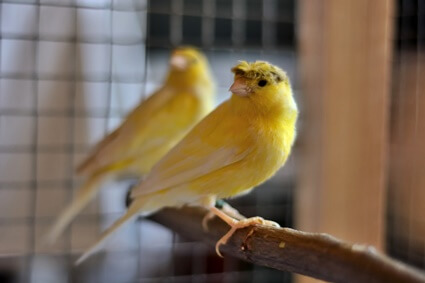
Weighing
If you can train your canary to sit on a tiny perch, secured on a scale and accounted for in weight, this makes weighing a canary easy. You can weigh the canary inside the cage if your scale is sufficiently sensitive.
Use a highly sensitive kitchen scale, as canaries are lightweight and won’t register on larger scales. Here’s how to weigh a canary in its cage:
- Take your canary out of its cage
- Weigh the cage.
- Place the bird back inside the cage
- Weigh the cage with the canary inside
- Subtract the first weight from the second
- The resulting number is your canary’s weight
Feeling The Keel
Feeling a canary’s keel is a quick and easy way to determine if your canary is getting fat.
The keel is an extension of the sternum that attaches to the wings. You can feel this body part at the center of the canary’s chest, which should feel like a small ridge. Here’s how to check:
- Hold your canary with bare hands. Wrap the bird in a cloth or towel to keep it still, if necessary.
- Run a fingertip over the center of the chest and feel for the keel.
- Move your fingertip to the left and right of the keel. These are the canary’s muscles.
- Keep the canary at a right angle so it goes straight across the muscles.
- The keel should be easy to find. If you’re having difficulty locating the ridge, it’s likely too fat.
Overweight birds will have large, soft muscles that cover the keel.
Well-exercised canaries will also have large muscles, but they’ll be firm. Birds of normal weight will have rounded muscles, where the keel isn’t hidden but also not jutting out.
Why Is My Canary Fat?
If you dedicate time, money, and effort to keeping your pet canary healthy, the fact that it’s now overweight may come as a surprise.
Understanding what leads to weight gain in domesticated canaries will enable you to resolve the problem and assist them in losing weight. The reasons for weight gain include:
Poor Diet
A canary that eats regularly but doesn’t gain enough nutrients from its diet can become obese.
It’ll naturally eat more to fulfill its body’s demands, but when it doesn’t gain the vitamins, minerals, antioxidants, and other nutrients it requires, it won’t stop.
In serious cases, it can leave a bird malnourished and struggling to absorb what nutrients it does gain.
So, a formulated, pelleted diet is ideal for canaries. Some brands are designed for specific life stages, as well as birds that are dealing with certain diseases.
This is especially important for canaries on an all-seed diet. Canaries are graminivorous, but they shouldn’t exclusively be fed seeds, as they’re often high in fat and low in nutrients.
If you offer seeds to your canary, only give it 1-2 teaspoons of high-quality seeds. Some are healthier than others, so avoid those high in fat and cholesterol.
Pellet diets should be supplemented with nutritious fruits and vegetables.
Sedentary Lifestyle
Canaries that live a sedentary lifestyle are more prone to becoming overweight, which happens when they’re placed in a cage too small for them to hop, fly, and explore.
Likewise, having no toys, physical interaction with humans, or time outside their cage may discourage exercise. If they don’t burn off the fat from meals, they’ll become overweight.
Genetics
A canary’s genes can leave it more prone to gaining weight. Canaries, alongside cockatiels and parakeets, are naturally predisposed to weight gain more than others.
That’s especially true in female and elderly canaries. Old canaries have the added disadvantage of lacking energy, thus making it harder to exercise. Meanwhile, females devote a lot of nutrients to egg-laying and chick-rearing, causing them to overeat to compensate.
Can Canaries Overeat And Die?
Overweight and obese canaries may form diseases that eventually cause death. According to Veterinary Medicine and Science, obesity can result in:
- Fatty liver
- Cardiovascular diseases
- Digestive issues, such as constipation
Each of these can reduce a canary’s lifespan. Even if obesity isn’t fatal, it’ll affect a canary’s quality of life. A bird that’s overweight or obese will have trouble moving, breathing, and communicating.
Can Canaries Get Too Fat To Fly?
Due to their high metabolism, canaries are motivated to fly in any situation unless they’re physically unable to. As they gradually develop fat, they’ll continue flying and adjusting to the weight difference.
In a way, they become stronger to compensate, but this isn’t sustainable indefinitely.
Eventually, a canary may become so obese that it’ll struggle to move. Once this happens, the canary often deals with more serious conditions due to weight gain. It’ll also be obvious that your canary requires a diet long before this point.
How Can I Help My Canary Lose Weight?
Providing your canary with opportunities to exercise will lead to weight loss. Methods include:
Increased Cage Size
Provide your canary with a cage big enough to move around in. The ideal size for a canary is 18 W x 18 D x 24 H in inches.
Canaries hop more often than they fly, so longer cages are preferred. If you can get an enclosure larger than the recommended size, your canary will enjoy the extra space.
Toys And Perches
Perches should be varied and placed on different levels to encourage movement, and toys should be changed out often to keep the engagement fresh.
Spend Time Out Of The Cage
Most canaries love time outside their cage because it allows them to fly, explore, and hop in new areas. If you have bird-proofed the room, allow it to roam under your supervision.
Singing
Canaries love to sing. Singing may appear less exhausting, but it takes energy. According to the Association for the Study of Animal Behavior, singing increases the metabolic rate of a canary.
So, play music, sing to your canary, and encourage it to sing back. Canaries have their preferences in music, and some like high-pitched songs because they sound similar to their melodies.
Water And Food Placement
Place your bird’s water and food bowls strategically to get it moving. For example, place each bowl on opposing ends of the cage and on different levels to encourage more activity.
